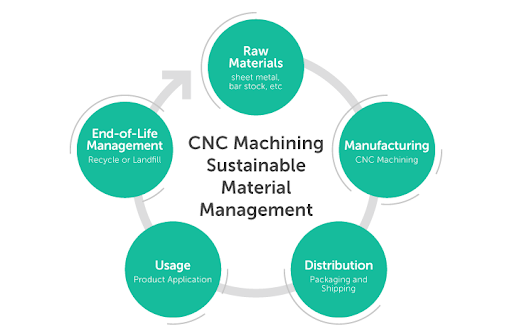Time to read: 5 min
You may be reading this because you’re personally committed to protecting the environment. Perhaps your organization has made bold sustainability commitments to your shareholders, customers, and society at large. Now it’s up to you to understand how such a rugged, industrial manufacturing process can be modified to fit the call to reduce carbon emissions (lower CO2 emissions) and improve sustainability. The good news is: that you can adjust the way you work to have a positive impact — and save your company money!
In our 2022 State of Manufacturing report, 63% of companies surveyed stated that product sustainability is increasingly important.
First, let’s highlight the importance of sustainability in our industry:
- Sustainability efforts can lead to cost savings. A 2020 report from Accenture showed that companies with responsible leadership in sustainability doubled or even tripled operating margins.
- Sustainability initiatives help to build trust between a company and its interested parties. McKinsey Sustainability surveyed Chief Executives and found that 83% believe that within the next 3-5 years, environmental, social, and governance sustainability programs will produce more shareholder value.
- Sustainability helps to foster long-term company growth. A sustainable mindset allows company leadership to develop goals that foster resilience and expansion.
- Build customer loyalty by promoting responsible climate-conscious corporate initiatives. (Viral sustainability marketing videos that invoke an emotional response like these are among some of my favorite advertisements.)
- Consumers want products that they can feel good about purchasing. I know that when I was looking for toys, bottles, plates, and utensils for my now 3-year-old, I loved seeing sustainable baby products like these.
- Sustainability helps to reduce the negative impacts of climate change. A 2022 Deloitte survey found that 89% of executives agree there is a global climate emergency. This topic is weighing on the minds of executives at your customer’s organizations as well.
- A sustainable mindset helps companies achieve the goals and requirements set forth by regulations like those created by the EPA.

There are five areas within the CNC machining lifecycle where sustainability can be introduced:
- Raw material selection and acquisition
- Manufacturing (CNC machining)
- Distribution (Packaging as well)
- Usage
- End of Life Management
The goal of this article is to provide information about how CNC manufacturing processes can be made more sustainable, including pre-CNC machining and post-CNC machining steps in the cycle shown above.
Raw Material Sourcing for Sustainability (Pre-CNC Machining)

You may be familiar with the importance of choosing the correct material for CNC machining to ensure the material is strong enough, able to withstand environmental conditions, and cost-effective. But your material selection process should also take sustainability into consideration; it’s the most important choice when trying to ensure a product can be sustainably managed throughout its lifecycle.
Chances are that you recycle in your household already, as the 2022 Deloitte Global Gen Z and Millennial Survey found that 90% of Gen Z and Millennials surveyed said that they were trying to reduce their environmental impact. And recycling is an excellent way to reduce your environmental impact at work, too.
When selecting materials for sustainability, bear in mind that some materials are ‘greener’ than others, as not all materials are recyclable. Aluminum and steel alloys are the most recycled metals because they are also commonly utilized and easy to recycle. Brass, bronze, cast iron, copper, titanium, and tin are also recyclable without a substantial loss in quality. Precious metals like silver, gold, or platinum are recyclable, too, and can yield a pretty penny when you do. Typically, non-ferrous metals will yield a higher return when recycled as well.
If you are looking to incorporate CNC machined plastic components, aim to choose something more easily recycled, like PET, HDPE, PVC, or LDPE. Avoid polystyrene as it is not recyclable. Also, note that most processing plants won’t deal with radioactive materials, mercury, or anything containing lead.
Pro-tip: when designing a product with sustainability in mind only utilize recyclable materials.
Tips to Improve Sustainability of Your CNC Machining Processes
There are various management schemes and disciplinary approaches to improving efficiency and eliminating waste in manufacturing processes, such as Kanban, Lean Manufacturing, etc.
Here are our best tips for increasing efficiency in your CNC machining processes:
- Utilize technology to help reduce material waste, like CNC nesting software that utilizes computer programming to yield the most parts for your raw materials, with a minimal amount of scrap.
- Train employees to cut down on scrap, which reduces errors and therefore reduces scrap, too.
- Perform a waste walk. Audit your production processes in their entirety and record all waste found along the audit. This may also be accomplished by process diagrams or value stream mapping.
- Recycle metal chips or swarf produced during CNC machining. You may be surprised at how much material you’re wasting!
- Ensure equipment and tools are well maintained or replaced before they start to negatively impact quality. This attention to detail reduces the risk of scrap parts.
- Replace antiquated CNC machinery that pulls more electricity than is necessary to reduce your spending on utilities and your carbon footprint at the same time.
- Consider a strategic partner for your CNC machining and digital manufacturing infrastructure where efficiency and sustainability are priorities.
Pro-tip: Upload your CNC parts for quoting in minutes in minutes and turnaround times as short as 3 days. Minimize cost and lead time without sacrificing quality.
Post-CNC Machining Sustainability Considerations

Improving Sustainability in Post-CNC Machining Distribution
Here are our best tips for improving the sustainability of your packaging:
- Use packaging studies to understand current packaging practices and highlight areas for improvement in material usage or efficiency across the entire product lifecycle.
- Use post-consumer recycled (PCR) and recyclable packaging for machined components or assemblies. Most major manufacturers have shifted their focus to sustainable packaging, and it’s simple to do with all the available variations.
- Avoid packaging with non-biodegradable plastics. Instead, look for biodegradable plastic alternatives.
- Avoid over-packaging. We all know of the joke that Amazon ships the smallest items in the biggest boxes; regardless of how hilarious this is – it’s neither efficient nor sustainable. Utilize the least number of materials to get your product from point A to point B.
Transportation of your product is also an area where companies can make positive impacts on sustainability. Look to green transportation methods such as:
- Consider inland barges as an alternative to conventional semi-trucks or rail transportation. Fifteen fully inland barges can be powered with a single towboat (diesel powered); the fifteen barges can carry the same amount of cargo as 225 rail cars or 870 semis while emitting much fewer greenhouse gasses and utilizing a fraction of the fuel.
- Look to emerging locomotive technologies, such as hybrid electric-diesel trains or next-generation efficient trains.
- Opt for hybrid or electric vehicles when supplying your fleet of delivery vehicles. Automotive manufacturers are definitely catering to our industry with their new vehicle offerings.
As you can see, material selection is critical for ensuring the sustainability of your CNC machined components. Intelligent labeling, showing that a product is recyclable also helps to ensure consumers are aware of the potential to recycle something.
Strategic Partnerships Advance Sustainability
Given the complexity inherent in advancing sustainability, strategic partnerships and expertise in designing for sustainability are critical. When you partner with China Manufacturing parts, our engineering design experts help guide your CNC machining to achieve your sustainability requirements, and we have a proven track record.
China Manufacturing parts makes it faster, easier, and more efficient to source and supply mechanical parts. Learn more about our CNC Machining Service and upload your parts files to get an instant quote and DFM feedback.

